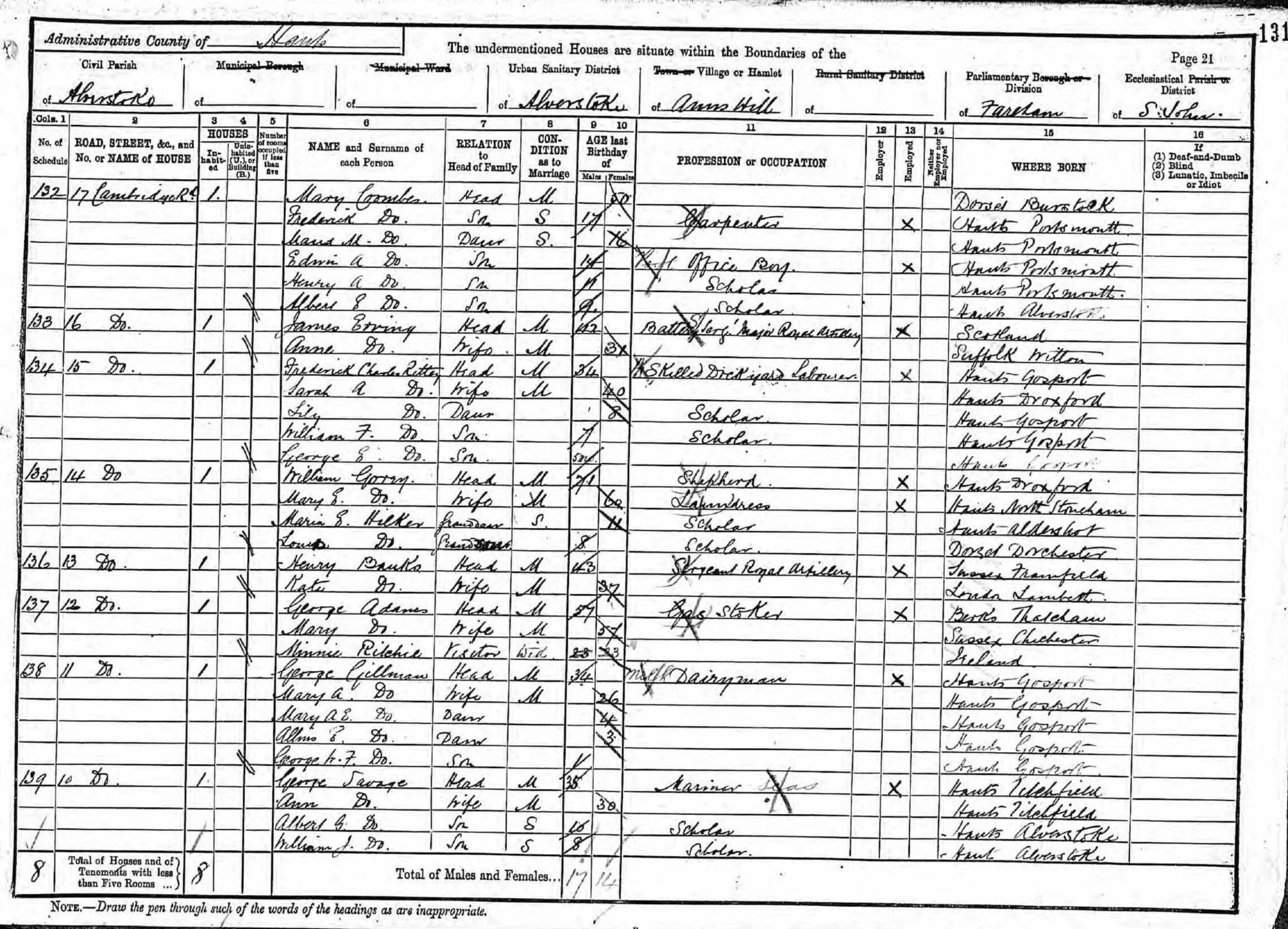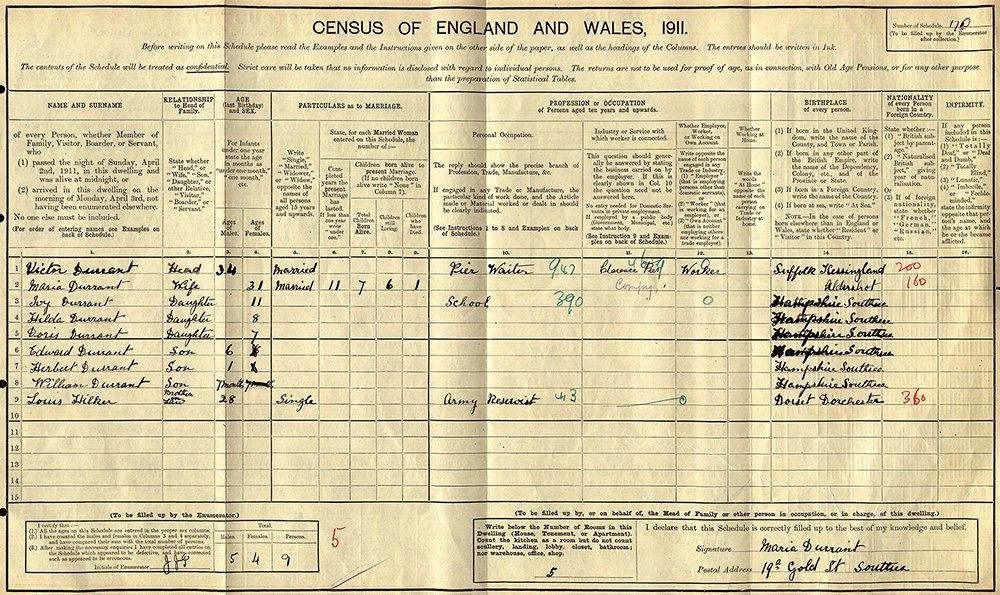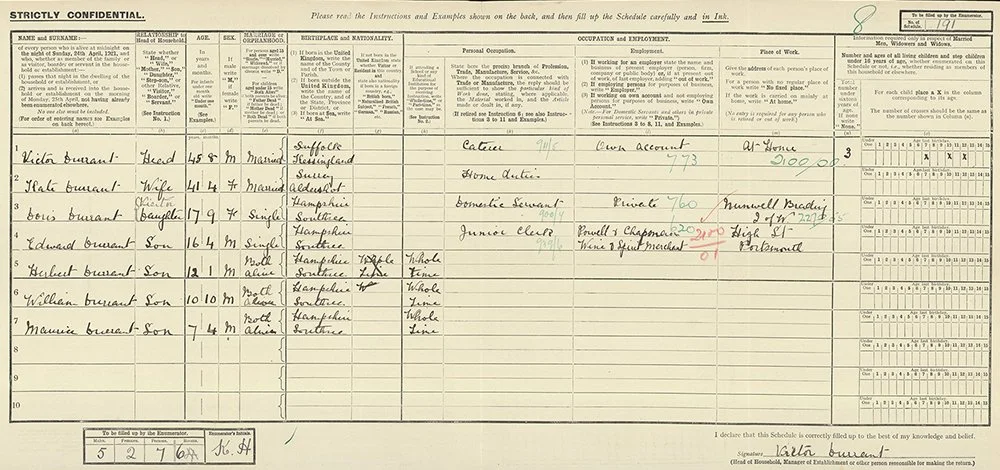Haunted by Death: Maria Efford Kate Hilker (1880-1957)
Much of Maria Efford Kate Hilker’s life was marred by death. She had witnessed three of her close family members die by the time she was eleven, undoubtedly leaving a lasting impression that likely haunted her entire life. Remembered by those that knew her as ‘Black Maria’, she was born on February 22nd 1880 in Aldershot to German-born soldier Ludwig (Louis) Hilker and his wife Maria Efford Gorey.
Maria Hilker’s Birth Certificate
The family were practising Anglicans, deciding to baptise Maria at Saint Mary the Virgin Church in Rowner, the parish church of Maria’s maternal grandparents. Less than two years after he wed Maria’s parents, Rector Edward Amyatt-Burney performed her baptism in the spring of 1880.
Maria Hilker’s Baptism Certificate
Louis, Maria’s father, was a serving Sergeant in the 109th Regiment. He was stationed at Aldershot Garrison (South Camp), where the British Army maintained a permanent training facility for its soldiers. The Army expected unwavering commitment and loyalty from its men, and marriage was actively discouraged [1]. Unable to stay together, Maria and her mother remained in the small village of Rowner, living in Rose Cottage, a small thatched dwelling [2], with her grandparents William Gorey and Elizabeth Smith.
1881 Census [3]
Nearby, more than 20,000 people lived and worked in the town and port of Gosport [4]. Substantial expansion of Portsmouth’s dockyard sparked rapid growth on the other side of the harbour, particularly in the late 18th and early 19th century, with Gosport providing many of the goods required to meet the growing demands of the navy. Rowner, in contrast, was exceedingly rural. The parish church was surrounded by open fields, arable and grazing land, mature woodlands, a scattering of farmsteads and cottages connected by trails, and the River Alver to its west. Despite living in a rural area, it was unlikely that Maria, her mother and grandmother worked the land. Employment of women and children in agricultural work was the topic of review in parliamentary commissions during the 1840s and had diminished significantly by 1850 [5].
Late 19th century map of Rowner. Potential location for the Gorey and Hilker families based on 1881 census address information and depicted with red circle [6]
A view of St Mary’s Church, Rowner (c. 1890) by Martin Snape, a celebrated local artist [7]
It appears the family were reunited for a time. Maria’s brother, Louis William John, was born in late spring of 1882 in Dorchester [8] and baptised in Blandford Forum, Dorset [9], two months later. A sister, Dorothea, quickly followed in 1885 [10]. By 1889, the family were living at 2 Maie Terrace (now known as Prospect Road), Fordington, Dorchester, next to the railway and a short distance from the military barracks, which supported the permanent military presence in the town.
Late 19th century map of Dorchester. Location of Maie Terrace outlined with a red circle [11]
Living on the western outskirts of Dortchester, Maie Terrace was part of the Victorian town expansion which had included the building of the Union workhouse on Damer Road in 1836 and Dorchester County Hospital in 1841 [12].
View of High West Street, Dorchester, taken from Westgate (c.1890s) [13]
In March of 1889, Maria’s mother gave birth to her second son, Frederick August. Tragedy rapidly struck. Frederick contracts meningitis and after battling illness for fourteen days passes away in the presence of nearby neighbour Eva Samson. The absence of both parents at this time is perplexing. One can only assume that Louis was deployed elsewhere as part of his military service. Maria (Senior) may have been forced to work or perhaps was so overwhelmed by grief that she was unable to deal with registering her infant son’s death.
Frederick Hilker’s Death Certificate [14]
In little over a year, Maria’s younger sister, Eva Elizabeth, is born. It is unclear if the birth was difficult but Maria’s mother succumbs to illness three months later. Contracting pneumonia, she passes away at home with husband Louis by her side. She was 29 years old.
Maria Hilker’s (Senior) Death Certificate [15]
Now a single father, Louis’ career prohibited his ability to care for his three young children and Maria and her siblings soon return to living with her maternal grandparents. This tumultuous period is further exacerbated when young Eva dies on Maria’s eleventh birthday. Eva passes away from meningitis triggered by tuberculosis, a disease which had reached epidemic proportions in Victorian Britain. Eva was one of more than four million people that died in England and Wales between 1851 and 1910 [16]. Eva was laid to rest alongside her mother and older brother, Frederick, in Fordington Cemetery [17].
Eva Hilker’s Death Certificate [18]
At the time of the 1891 census [19], a few months later, Maria and her younger brother Louis (Junior) are residing at 14 Cambridge Road in Alverstoke while father, Louis, is serving with the 3rd Dorset Regiment and staying at the depot barracks in Fordington, Dorchester, Dorset [20]. However, Dorothea is boarding with the Biles family in Allington, Bridport, Dorset [21]. It’s unclear why Dorothea, the youngest living child, has been separated from the family. From this point it is unlikely the family were reunited often or for extended periods of time particularly given the military demands on Louis. There is no evidence that Maria ever returns home to Dorchester, instead, she makes Portsmouth, Hampshire her home after meeting future husband, Victor William Durrant.
1891 Census [19]
Maria may have met Victor while he was serving on Nelson’s famous flagship, HMS Victory. During the late 1890s the ship was anchored on the Gosport side of Portsmouth harbour, training sailors as a Naval Signal School [22].
Gosport side of Portsmouth harbour. HMS Victory moored nearest to shore (top right) c. 1900 [23]
By 1899 Maria is pregnant with her first child, she is 19 years old and using her middle name, Kate. Unmarried, Maria and Victor attempt to avoid any hint of impropriety. They make their home on Peckham Street, near Palmerston Road and list themselves as a married couple on Ivy Dorothea Victoria’s birth certificate [24].
Ivy Dorothea Victoria Durrant’s Birth Certificate [24]
At the time of the 1901 Census, Maria, Victor and Ivy were living on Broad Street in Southsea [25]. Maria’s family are finally reunited with Maria’s father, Louis Hilker Senior (now an army pensioner), and her younger siblings, Louis Hilker Junior (a stable man), and her sister, Dorothea (a cigarette-making apprentice) are residing with the young couple.
1901 Census [25]
Sometime in 1902 Victor and Maria welcome their second daughter, Hilda Florence Constance. Their third daughter Doris Gladys quickly follows in 1903. This, along with the death of Maria’s father [26] may have prompted their subsequent move to 21 Gold Street in Southsea a year later [27].
Their first son and fourth child, Edward Louis Victor, is born in early 1905. That same year the family move again. This time to 85 St Vincent Street [28].
In 1906, Maria gives birth at her home to her fourth daughter, Eva, named after the sister who passed away fifteen years prior. Within hours, baby Eva begins convulsing and dies. The pain and sorrow is unimaginable. Maria must have been devastated, reminded of her deceased relatives.
Eva Durrant’s Birth Certificate [29]
Eva Durrant’s Death Certificate [30]
Despite living together for a number of years, having several children and sharing a last name, Maria and Victor had not been married. This all changed on January 2nd 1907. The couple were married by certificate at the Register office in Alverstoke [31].
Marriage Certificate for Victor Durrant and Maria Hilker [31]
The absence of any family witnesses and the misrepresentation of their residence suggest the couple were married in secret. Surprisingly, unmarried cohabiting couples were not unusual at the time [32]. A past marriage that could not be dissolved was the main factor motivating couples to chose this lifestyle. However, this doesn’t seem to be the case here. Perhaps Maria and Victor were a progressive family, protesting against the institution. Was Maria more educated and independent than her female ancestors? Maybe the couple were waiting to marry until they could afford to be an independent household or were relatively indifferent to marriage. Perhaps the passing of Eva prompted the couple to marry. Whatever the reason, the social and economic costs were much greater for women. Women and children were more likely to face social snubs and were particularly vulnerable should the male partner leave the relationship. Maria must have trusted Victor implicitly.
Victor clearly acknowledged his children and they appear to have been raised as legitimate. That said, a child born out of wedlock publicised illicit sexuality and less than 5% of all births in the early part of the 20th century were to unmarried women [33]. There were also few, if any, legal protections for the growing family. The legal distinction between illegitimate and legitimate did not exist until 1987, with the introduction of the Family Law Reform Act [34], meaning Maria had sole legal responsibility for her children should Victor die.
Between 1907 and 1908 the family move again, this time returning to Gold Street (19a – Arundel House apartments) [35]. Maria falls pregnant again. She gives birth to Herbert George in 1909 and William Arthur in 1910.
During this period, the tactics of the Women’s Social and Political Union were becoming increasingly militant as they fought for women’s suffrage. By 1911, the Women’s Freedom League was calling on women to boycott the census as part of the campaign for ‘Votes for Women’. Despite this, Maria completes the family’s census entry [36]. The expected gender roles have been adopted, with Victor as the breadwinner. Maria is not working, which is understandable given that she has six children, but she is clearly educated and literate.
Publication issued by the Women’s Freedom League [38]
1911 Census [36]
The couple’s final child is born in early 1914. Maurice is Maria and Victor’s seventh child and fourth son. The family’s joy would be short-lived with tensions rising in Europe. Britain joins the conflict on August 4th 1914. At some point, despite his age, Victor joins the war effort and serves on the frontline [37].
Maria, left alone to care for her family, would have had to deal with rocketing food prices and widespread shortages. By December 1916, the government had set up a Ministry of Food to regulate the supply and consumption of food [39]. The situation was increasingly dire and Maria, like other women, may well have missed meals to ensure her children were fed [40]. Given the age of her children, it is unlikely that she would have been able to take on a role associated with the war effort to supplement the family’s income.
Food queues during World War One [41]
By the time Maurice is four years old, Spanish Flu has emerged, exacerbated by returning soldiers, and is destroying families across the county. The Times described the epidemic as:
“the most fatal visitation in recorded history. So vast was the catastrophe and so ubiquitous its prevalence that our minds, surfeited with the horrors of war, refused to realise it. It came and went, a hurricane across the green fields of life, sweeping away our youth in hundreds of thousands and leaving behind it a toll of sickness and infirmity which will not be reckoned in this generation [42]”
It is easy to imagine the terror that Maria would have faced expecting illness to befall her family at any point. Thankfully, the family escaped unscathed and in 1921 appear to be living contently with four young sons.
1921 Census [43]
Before the decade is out, Maria’s brother, Louis, dies at the age of 47 never fully recovering from his war-time experiences.
Maria continues to be a homemaker as Victor establishes a successful seaside café business; her occupation is listed as ‘unpaid domestic duties’ in the 1939 Register [44]. Even though their children are all of adult age, son Maurice is living with them while on a brief shore leave from the merchant service. Leonard Hawkins, their oldest grandchild, is also staying.
1939 England and Wales Register [44]
Maria may have felt some relief when war broke out that same year, knowing her husband could no longer serve on the front-line. In addition, it seems that only her son Maurice saw action serving on merchant vessels throughout the war. The relief would have been short-lived with German bombing raids beginning in the summer of 1940 bringing the reality of war much closer to home.
Victor and Maria experienced one of these raids firsthand on September 9th 1940 when a bomb landed on the corner of Gold Street and Stone Street [45]. However, the most devastating attack took place on the night of January 10th 1941 when over a hundred German planes dropped 25,000 incendiary devices and hundreds of high explosive bombs on the city of Portsmouth. It’s possible that Victor and Maria took refuge in one of the city’s many public air raid shelters, listened to the air raid sirens wailing throughout the night and emerged the following morning surrounded by mounds of rubble and contorted steel. A witness at the time describes “leaving the air raid shelter, the night sky was red with fires, smoke was everywhere and the smell was acrid [46]”.
Palmerston Road, Southsea during the Blitz c. 1940 [47]
In July 1942, Maria’s beloved sister, Dorothea, passes away after suffering a long illness [48]. Maria is the remaining Hilker descendent, outliving all her younger siblings.
Maria is by Victor’s side when he passes away in 1947 [49]. After almost five decades together, the loss must have been debilitating and Maria may have felt entirely alone and incomplete with a void impossible to fill. This would have been exacerbated with the passing of her son, Herbert less than two years later [50]. Herbert appears to have been living with Maria at 16 Castle Street and in receipt of a disability pension from the Royal Air Force before being admitted to St James’ Hospital. He died suddenly of an internal haemorrhage from a duodenal ulcer but was also suffering from pulmonary tuberculosis. It is unclear if his admission to the hospital was linked to mental health issues or the need for treatment for tuberculosis. St James’ Hospital was delivering many hospital services [51] following the destruction of the Royal Portsmouth Hospital [52] during war-time bombing and the recent creation of the National Health Service. Maria reports Herbert’s death and may well have been responsible for organising his funeral arrangements.
Despite the loss of both husband and son, Maria lives on another eight years. On January 5th, 1957, she succumbs to heart disease caused by hardening of the arteries [53]. At the age of seventy six, she has watched her mother, father, husband, four siblings (Eva, Dorothea, Fredrick and Louis) and two children (Eva and Herbert) die.
Maria’s Death Certificate [53]
References:
























